INSTRUCTIONS TO CANDIDATES
- Write your Name, School and Index number in the spaces provided.
- Answer all questions in section A in the spaces provided. In Section B, answer question 6 (compulsory) and either 7 or 8 in the spaces provided after question 8.
- Candidates should answer all the questions in English.
FOR EXAMINERS USE ONLY
| SECTION | QUESTION | MAXIMUM SCORE | CANDIDATES SCORE |
| SECTION A | 1 | 8 | |
| 2 | 8 | ||
| 3 | 8 | ||
| 4 | 8 | ||
| 5 | 8 | ||
| SECTION B | 6 | 20 | |
| 7 | 20 | ||
| 8 | 20 | ||
| TOTAL SCORE | 100 |

QUESTIONS
SECTION A
(Answer ALL questions in this section)
- In a biology lesson, some students obtained a young stem and split it half way along the length as shown in diagram A. They then placed it in solution Y for two hours before making observations, The results were as shown in diagram B.
- What was the nature of solution Y? (1 mk)
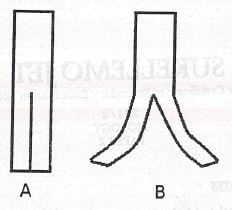
- Explain why the stem curved as shown in diagram B. (4mks)
- State three roles of active transport in organisms. (3mks)
- What was the nature of solution Y? (1 mk)
-
- In human, premature baldness is controlled by a gene on the Y chromosome. Using B to represent the gene for baldness, work out a cross between a bald man and his wife. (4 mks)
-
- What is the probability of their daughters being bald? (1 mk)
- Give a reason for your answer. (1 mk)
- Name one trait in human beings that is determined by multiple allele (1mk)
- Name one genetic disorder affecting the human eye (1 mk)
- The experiment below was set-up to investigate some physiological processes. The glucose solution was first boiled then cooled. The set-up was left for 24hrs.
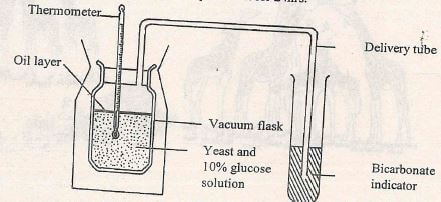
- Suggest two aims of the experiment. (2mks)
-
- State the expected observations after 24 hours. (2mks)
- Explain your observations in a (i) above. (1 mk)
- Why was glucose solution boiled then cooled? (1 mk)
- Suggest a control for the above experiment (1 mk)
- State the practical application of the process being investigated in industry (1 mk)
- The picture below represents an evolutionary phenomenon. Study it and answer the questions below.
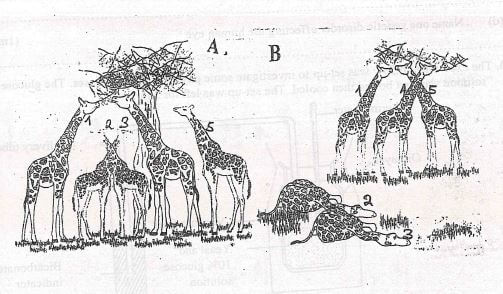
- What name is given to the above evolutionary phenomenon? (1 mk)
- Account for your observation in pictures A and B
Observation......................................(2 mks)
Accounting.......................................(2 mks) - Explain how continental drift is an evidence for organic evolution (3 mks)
- An analysis was done on the contents of faeces of a cow. The results are as shown in the table below.
Content
Percentage Carbohydrates 12 Proteins 0.8 Fiber 14 Fats 1 - Name the other component that makes up the faeces of a cow and give its percentage. (1 mk)
- Name the substance that contributes the fiber in the faces. (1 mk)
- Cow faeces are normally used as fertilizer that increases nitrates in the soil.
- State the component in the faces that yield nitrates. (1 mk)
- Describe how the component named in (c)(i) above is converted into nitrates (4 mks)
- Explain why the manure would be better if the cows urine was added to the faces. (2 mks)
SECTION B (40 Marks)
Answer question 6(Compulsory) and either question 7 or 8 in the spaces provided after question 8
- The table below shows how the quantities of sweat and urine vary with external temperature.
External Temperature (°C) Urine (cm3/hour) Sweat(cm3/hour) 0 100 5 5 90 6 10 80 10 15 70 20 20 60 30 25 50 60 30 40 120 35 30 200 - On the grid provided, plot graphs of quantities of urine and sweat produced against external temperature. (7 mks)

- At what temperature were the amounts of sweat and urine produced equal? (1 mk)
- Account for the shape of the graph for:
- Amount of urine produced (3 mks)
- Amount of sweat produced. (2 mks)
- State two ways in which the skin lowers body temperature. (2 mks)
- State the advantages of having constant body temperature in mammals. (3 mks)
- State the role of the hypothalamus in thermoregulation. (2 mks)
- On the grid provided, plot graphs of quantities of urine and sweat produced against external temperature. (7 mks)
- Describe the process of hearing in man. (20 mks)
-
- Explain the role of the following plant hormones in growth and development.
- Gilberellins (5 mks)
- Cytokinin (5 mks)
- Describe the process of fertilization and implantation of the zygote in mammals. (10mks)
- Explain the role of the following plant hormones in growth and development.

MARKING SCHEME
-
- hypotonic; (1 mk)
- Solution Y was hypotonic to cell sap of the cortical cells; The epidermal cells are covered with waxy cuticle hence do not take in water by osmosis; while the cortical cells with thin walls take in water by osmosis. They therefore become turgid; hence the stem curves outwards. (4mks)
- Absorption of end products of digestion in intestines; absorption of salts in the colon; re absorption of substances (any
correct) in kidney tubules; (3mks)
-
- Parents Man♂/ Wife/♀
XYB X XX
Rej - the mark for genotypes if the X is missing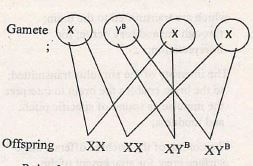
Rej - the mark for fusion lines if they penetrate the gametes. -
- 0; ace - zero/none (1 mk)
- The gene for baldness is located on the Y chromosome which the girls lack;
- Blood group;
- Colour blindness; reject colour blind
- Parents Man♂/ Wife/♀
-
- To find out whether energy/ heat is released in anaerobic respiration/ fermentation;
To investigate the gas produced during fermentation/anaerobic respiration; (2marks) -
- (significant) rise in temperature; color of bicarbonate indicator turns yellow; (2marks)
- Yeast will respire aerobically releasing energy/ and carbon dioxide gas that turn indicator yellow; mark
- Expel / drive out oxygen; 1mark iv) Use glucose solution without yeast cells/ killed yeast cells; 1mark
- Brewing; 1 mark
Baking;
Production of dairy products; Mark any 1
- To find out whether energy/ heat is released in anaerobic respiration/ fermentation;
-
- Natural selection; (1 mk)
- Observation (2 mks)
- A-Long-necked giraffes survived;
- B -short-necked giraffes died from starvation;/perished
Accounting (2 mks) - Nature selected those giraffes with long necks allowing them to survive; while rejecting those with short necks thus eliminating them; OR Natural selection favours survival of giraffes long-necked traits, and rejects/eliminates those with short-necked traits;
- Current continents existed as one large land mass/Pangea/ Lauresia; the present continents drifted leading to isolation of organisms; organisms in each continent evolved along different evolutionary lines; (3mks
-
- Water; 72.2%;
- Cellulose;
-
- Proteins;
- Proteins are broken down to ammonium compounds/ammonia; by saprophytic bacteria /fungi/microorganism; Ammonia is converted into nitrites by Nitrosomonas/Nitrococcus bacteria; nitrites are converted into nitrates by nitrobacter(bacteria);
- Urine contains urea/nitrogenous compounds; that add to the protein content of the feaces;
-
-
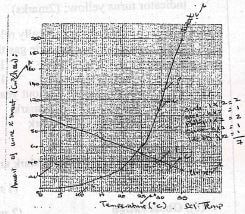
- 24 °C (+ 1 or -1); Rej- without units
-
- An increase in temperature leads to decrease in the amount of urine produced; because of increased sweating which increases osmotic pressure of blood; hence more water is reabsorbed in the kidney tubules;
- An increase in temperature results to increased sweat production; high temperature increases evaporation rate; hence more sweat is converted to vapour (to cool the body);
- Vasodilatation;
Hair lies flat; - Mammals are active even under cold conditions/always;
Able to escape from predators/search for food because they are active always;
Can survive in both hot and cold habitats/ wide range of habitats; - Contains thermoreceptors that detect changes in temperature (of blood); and generate impulses to the appropriate organs/structures;
-
- The pinna; collects/channels sound waves; into the auditory canal/meatus; Auditory canal concentrates directs sound waves; to the tympanic membrane/ear drum; The sound waves heat the ear drum and cause it to vibrate; The vibrations are transmitted to the ear ossicles/from the ear drum the vibrations are picked by malleus which transmits them to the incus then to the stapes; Stapes passes the vibrationsto the oval window/fenestra ovalis; from where the vibrations are transmitted to the fluid in the cochlea; the vibrations stimulate sensory cell hairs; to generate impulses; which are transmitted to the brain; through the auditory nerve; for interpretation; The intensity of the stimulus transmitted; to the brain enables the brain to interpret the impulse as sound of specific pitch; and loudness; The coiling of the cochlea offers a large surface area; for attachment of the sensory cells; Vibrations in the fluid in the inner ear are dissipated; by the round window; (20mks)
-
-
- Gibberellins;
Promote cell division /elongation; stem elongation in dwarf plants; Initiates formation of IAA; Promotes formation of side branches on stems; Inhibits growth of adventitious roots;
Activates hydrolytic enzymes during germination/promote seed germination /breaks seed dormancy Promote leaf expansion; leaf abscission; 6 max 5mks - Cytokinins
Promotes cell division (in presence of auxins/IAA);
Promotes root formation on a shoot;
Breaks dormancy in some species;
Cytokinins plus AA induces formation of callus tissue;
Stimulates lateral bud development;
Low concentration encourages leaf senescence and enlargement in leaves; 7 mks (5mks)
- Gibberellins;
-
- It occurs at the upper part of the oviduct after copulation;
- Sperms are drawn by section of cervix to the uterus
- Sperms swim up to the oviduct using their tails
- When sperms come into contact with the egg the aerosome bursts
- Releasing lytic enzymes that dissolve the egg membrane
- The aerosome turns inside-out forming a fine filament that penetrates the egg;
- The head of the sperm enters the ovum and tail left behind;
- Vitelline membrane changes to prevent further entry of sperm to ovum
- Male nucleus fuses with female nucleus forming adeploid zygote
- Zygote undergoes a series of mitotic divisions forming blastocytes
- Blastocytes develop villi which grows into uterus
- Villi together endometrium develop the placenta
- Blastocytes become embryo after implantation
- Implantation take place in the uterus
- Zygote moves from oviduct to uterus by cilia movements and contractions of smooth muscles along the oviduct
-
Download Biology Paper 2 Questions and Answers - Sukellemo Joint Mock Examinations July 2020.
Tap Here to Download for 50/-
Get on WhatsApp for 50/-
Why download?
- ✔ To read offline at any time.
- ✔ To Print at your convenience
- ✔ Share Easily with Friends / Students

